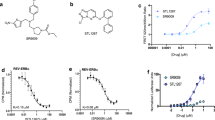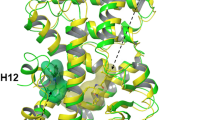Abstract
RETINOID X receptor (RXR) plays a central role in the regulation of many intracellular receptor signalling pathways1 and can mediate ligand-dependent transcription, acting as a homodimer or as a heterodimer1–6. Here we identify an antagonist towards RXR homodimers which also functions as an agonist when RXR is paired as a heterodimer to specific partners, including peroxi-some proliferator-activated receptor and retinoic acid receptor. This dimer-selective ligand confers differential interactions on the transcription machinery: the antagonist promotes association with TAF110 (TATA-binding protein (TBP)-associated factor 110) and the co-repressor SMRT7, but not with TBP, and these properties are distinct from pure RXR agonists. This unique class of RXR ligands will provide a means to control distinct target genes at the level of transcription and allow the development of retinoids with a new pharmacological action.
This is a preview of subscription content, access via your institution
Access options
Subscribe to this journal
Receive 51 print issues and online access
$199.00 per year
only $3.90 per issue
Buy this article
- Purchase on Springer Link
- Instant access to full article PDF
Prices may be subject to local taxes which are calculated during checkout
Similar content being viewed by others
References
Mangelsdorf, D. J., Umesono, K. & Evans, R. in The Retinoids (eds Sporn, M. B., Roberts, A. B. & Goodman, D. S.) 319–349 (Adacemic, New York, 1994).
Forman, B. M., Umesono, K., Chen, J. & Evans, R. M. Cell 81, 541–550 (1995).
Willy, P. J. et al. Genes Dev. 9, 1033–1045 (1995).
Perlmann, T. & Jansson, L. Genes Dev. 9, 769–782 (1995).
Kliewer, S. A., Umesono, K., Noonan, D. J., Heyman, R. A. & Evans, R. M. Nature 358, 771–774 (1992).
Mangelsdorf, D. J. et al. Cell 66, 555–561 (1991).
Chen, J.-D. & Evans, R. M. Nature 377, 454–457 (1995).
Meyer, M. E. et al. EMBO J. 9, 3923–3932 (1990).
Danielian, P. S. et al. Mol. Endocrinol. 7, 232–240 (1993).
Kurokawa, R. et al. Nature 377, 451–457 (1995).
Kurokawa, R. et al. Nature 371, 528–531 (1994).
Fanjul, A. et al. Nature 372, 107–111 (1994).
Nagpal, S., Athanikar, J. & Chandraratna, R. A. J. Biol. Chem. 270, 923–927 (1995).
Chen, J. Y. et al. EMBO J. 14, 1187–1197 (1995).
Horlein, A. J. et al. Nature 377, 397–404 (1995).
Schulman, I. G., Chakravarti, D., Juguilon, H., Romo, A. & Evans, R. M. Proc. Natl Acad. Sci. USA 92, 8288–8292 (1995).
Canan-Koch, S. S. et al. J. Med. Chem. 39, 3229–3234 (1996).
Boehm, M. F. et al. J. Med. Chem. 38, 3146–3155 (1995).
Heyman, R. A. et al. Cell 68, 397–406 (1992).
Levin, A. A. et al. Nature 355, 359–361 (1992).
Allegretto, E. A. et al. J. Biol. Chem. 268, 26625–26633 (1993).
Boehm, M. F. et al. J. Med. Chem. 37, 408–414 (1994).
Fields, S. & Song, O. K. Nature 340, 245–246 (1989).
Mukherjee, R., Jow, L., Noonan, D. & McDonnell, D. P. J. Steroid Mol. Biol. 51, 157–166 (1994).
Rottman, J. N. et al. Mol. Cell. Biol. 11, 3814–3820 (1991).
Roy, B., Taneja, R. & Chambon, P. Mol. Cell. Biol. 15, 6481–6487 (1995).
Nagpal, S., Friant, S., Nakshatri, H. & Chambon, P. EMBO J. 12, 2349–2360 (1993).
Lanotte, M. et al. Blood 77, 1080–1086 (1991).
Renaud, J.-P. et al. Nature 378, 681–689 (1995).
Bourguet, W. et al. Nature 375, 377–382 (1995).
Author information
Authors and Affiliations
Rights and permissions
About this article
Cite this article
Lala, D., Mukherjee, R., Schulman, I. et al. Activation of specific RXR heterodimers by an antagonist of RXR homodimers. Nature 383, 450–453 (1996). https://doi.org/10.1038/383450a0
Received:
Accepted:
Issue Date:
DOI: https://doi.org/10.1038/383450a0
This article is cited by
-
Structural analysis identifies an escape route from the adverse lipogenic effects of liver X receptor ligands
Communications Biology (2019)
-
Tributyltin induces a transcriptional response without a brite adipocyte signature in adipocyte models
Archives of Toxicology (2018)
-
The multi-faceted role of retinoid X receptor in bone remodeling
Cellular and Molecular Life Sciences (2017)
-
Antagonist-perturbation mechanism for activation function-2 fixed motifs: active conformation and docking mode of retinoid X receptor antagonists
Journal of Computer-Aided Molecular Design (2017)
-
In vivo activation of PPAR target genes by RXR homodimers
The EMBO Journal (2004)
Comments
By submitting a comment you agree to abide by our Terms and Community Guidelines. If you find something abusive or that does not comply with our terms or guidelines please flag it as inappropriate.



